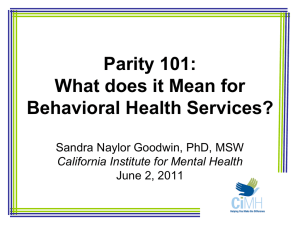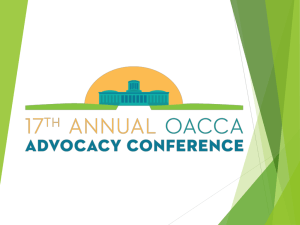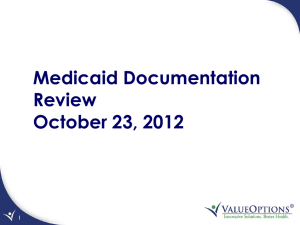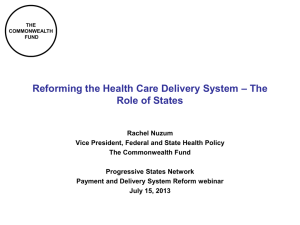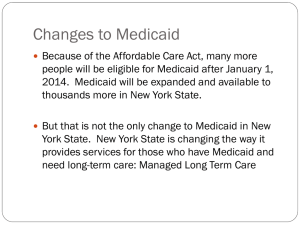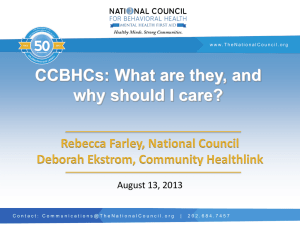the PowerPoint - Arkansas Psychiatric Society
advertisement
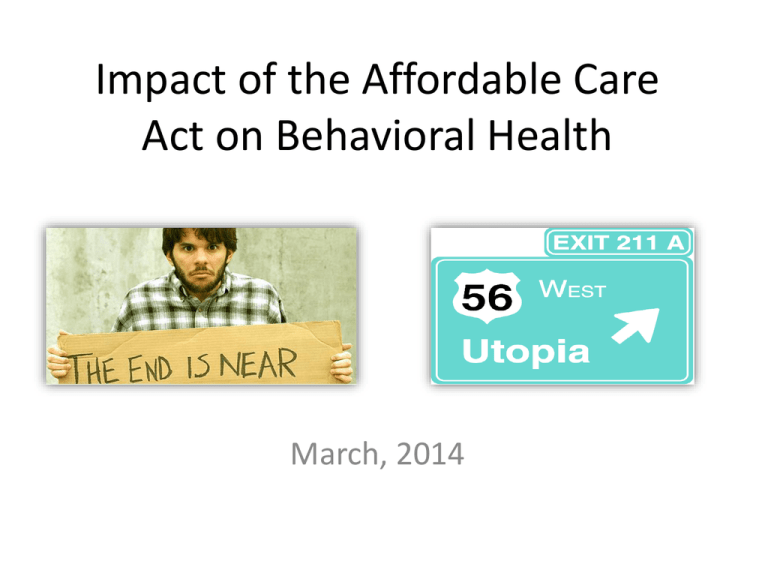
Impact of the Affordable Care Act on Behavioral Health March, 2014 My Background • • Medicaid Director Previously DMH Medical Director – 20 years Practicing Psychiatrist CMHCs – 10 years FQHC – 18 years • Distinguished Professor, Missouri Institute of Mental Health, University of Missouri St. Louis Endorsements • "He is not only dull himself, he is the cause of dullness in others.“-Samuel Johnson • "He uses statistics as a drunken man uses lamp-posts... for support rather than illumination." -- Andrew Lang • "He can compress the most words into the smallest idea of any man I know." -- Abraham Lincoln Today… It’s not just Arkansas •Status of our world •Healthcare delivery and payment “change” strategies •Future of specialty behavioral health Our niche: caring for complex, costly patients Socially vulnerable patients Clinically vulnerable patients (income, language, race/ethnicity, health disparities) (complex, difficult healthcare needs) You Are Here Source: Health Affairs: VA Lewis, et al. “The Promise and Peril of Accountable Care for Vulnerable Populations: A Framework for Overcoming Obstacles.” 2012. Co-morbidities in the Adult Population Source: Druss & Walker. “Mental disorders and medical comorbidity.” The Robert Wood Johnson Foundation Synthesis Project, February 2011. Opportunities… Defined by Tragedies Sandy Hook Tucson Aurora Virgini a Tech 2020, behavioral health disorders surpass all physical diseases as major cause of disability MI most common reason for SSD/SSI More deaths due to suicide than to accidents, homicides, and war combined Most mental health treatment is in primary care - medication, poorly managed 7 Effective Treatments www.TheNationalCouncil.org 9 million people will gain access to coverage that includes MH/SUD at parity Parity Robust final rule 11 Role of Parity – Essential Health Benefit (EHB) for private insurance must be at parity. What does parity mean? – Medicaid Benchmark Benefit must be at parity. – Parity does extend to all new individual and small group plans beginning in 2014. – What about parity for current Medicaid beneficiaries? State Estimates of the Uninsured • You can access state estimates for the Medicaid Expansion and for the State Health Insurance Marketplace at http://www.samhsa.gov/healthReform/enrollment.aspx • Three estimates are provided: – Adults with Serious Mental Illness – Adults with Serious Psychological Distress – Adults with a Substance Use Disorder Essential Benefit Plans (EBP) on the Insurance Exchanges • The plan selected by a state to be its EBP benchmark for ACA may not comply with parity. • States had until exchanges went live to make it comply with parity - then it became an EHB benchmark plan • But so far its unclear if CMS will enforce this – especially since the final ACA rule stated that “We do not intend to require or request states to include specific services within EHB categories offered by their ABP.” • States resisting ACA implementation will not enforce it either • High deductibles and co-pays will be an obstacle Alternative Medicaid Benefit (AMB) for Medicaid Expansion Groups • Wellstone – Domenici Parity does not apply • If the individual meets that states definition for “medically frail” they reverts to the standard Medicaid benefit • Serious Mental Illness and Substance Use Disorders constitute Medically Frail • But - states get to define which diagnosis is “SMI” • Many states are not expanding Medicaid Parity and Case Law Monitoring and reporting… •Anthem Health Plans’ Connecticut rate schedule changes violate the Mental Health Parity and Addiction Equity Act •New York against UnitedHealth Group •California class-action lawsuit against United Behavioral Healthcare for reviews of outpatient treatments •Vermont held Cigna has burden of proving that disparate treatment of mental health and medical surgical justified by clinical standards Four key elements of the Affordable Care Act 2010 • Prohibits lifetime benefit limits • Dependent coverage up to age 26 is mandated • Cost-sharing obligations for preventive services are prohibited • Recissions are prohibited • Pre-existing condition exclusions for dependent children (under 19 years of age) are prohibited • Coverage for emergency services at in-network cost-sharing level with no prior-authorization is mandated More 2010 • Require coverage of tobacco cessation programs for pregnant women under Medicaid free of cost-sharing • Begin Community Health Centers and National Health Service Corps Fund expanded funding to total $11 billion over five years • Begin Medicaid global payments demonstrations to fund large, safety-net hospitals in five states to alter payment from feefor-service to a capitated, global payment structure. • Establish Patient-Centered Outcomes Research Institute. Create a private, nonprofit Patient-Centered Outcomes Research Institute to set a national research agenda and conduct comparative clinical effectiveness research. 2011 • 85% MLR for large group (with refund) is mandated • 80% MLR for individual and small group (with refund) is mandated • Primary care physicians and General surgeons in shortage areas begin 10 percent Medicare payment bonus for next 5 years • Medicare adds annual wellness visit with no copayment or deductible and eliminates cost-sharing for evidencebased preventive services 2012 • Medicaid starts option funding Health homes for persons with chronic conditions • Prohibit federal payments for Medicaid services related to hospital-acquired conditions. • Begin Medicaid Emergency Psychiatric Care Demonstration Project. to expand the number of emergency inpatient psychiatric care beds available. 2013 • Medicaid payment rates to primary care physicians for furnishing primary care services raised no less than 100 percent of Medicare payment rates in 2013 and 2014. • Medicaid coverage of preventive services approved by the U.S. Preventive Services Task Force with no cost-sharing will receive an increased federal funds 2014 • Health insurance exchanges established • Guarantee issue is required • Community rating required limits use of age and illness as a rating factor • All annual and lifetime limits prohibited • Essential Benefit established and required to cover MH and SA at Parity • Individual Mandate Starts Insurance Exchanges • To Date: – 16 states have selected a state-based model, – 7 are partnering with the federal government and – 26 states have chosen federally-run exchanges. • Current enrollment deadline is March 31, 2014 • In non- expansion states low-income individuals may experience more difficulty finding affordable coverage because they are not Medicaid-eligible and do not qualify for federal subsidies in the exchange. ACA Affordable Health Insurance Marketplace • Fact: Enrollment system went live in ALL STATES on October 1, 2013. Insurance will became effective on January 1, 2014. Scope is all uninsured adults above 133 percent of poverty (plus discounted 5 percent of income). • Overall 25% will have a Behavioral Health Condition. (About 6% will have a Serious Mental Illness and 14% will have a Substance Use Disorder). • KEY ISSUES TO CONSIDER: – Are eligible uninsured persons aware of the opportunity? – Will persons with mental health and substance use conditions actually enroll? – Will the insurance benefits be adequate? 2014 Medicaid Expansion • To date, 26 states are planning to expand coverage in 2014 • Some include non-traditional models such as Medicaid premium support. • Decisions to expand Medicaid or discontinue Medicaid expansion in 2015 will impact bids that insurers submit in the spring of 2014 for the 2015 enrollment period. ACA Medicaid Expansion • Fact: For states that choose this option (now 26 + DC), enrollment system went live on October 1, 2013 and coverage began on January 1, 2014. Designed for all uninsured adults up to 133 percent of poverty (plus discounted 5 percent of income). • Overall 40% with Behavioral Health Conditions. (About 7% will have a Serious Mental Illness and about 14% will have a Substance Use Disorder). • KEY ISSUES TO CONSIDER: – What is the effect of a State opting out? – Are eligible uninsured persons aware of the opportunity? – Will persons with mental health and substance use conditions actually enroll? Increased competition in MH/SUD • Managed care • Accountable Care Organizations • New MH/SUD coverage under essential benefits • New parity requirements EHR Meaningful Use Behavioral Health Quality Measures (Phase 2) • Quality metrics for chronically ill: – – – – • • • • • • Tobacco screening and cessation Weight screening and counseling Depression screening and intervention Hypertension screening Depression remission rates using PHQ9! Depression followup using PHQ9 Substance Abuse assessment in Bipolar patients Alcohol Treatment initiation and Engagement Maternal depression screening at < 6 month child visit Suicide assessment for depressed patients 30 Delayed Changes • Employer mandate delayed from 2014 to 2015 • First reduction of Disproportionate Share Hospital (DSH) funds delayed from 2104 to 2015 • Compliance of small business Existing Plans with new Rules – – – – CMS has delayed until September 2015 15 States will permit renewal of non-compliant plans 18 States will not 17 States are undecided 2015 - 2017 • Innovation Waivers – Beginning 2015, states may consider developing proposals to waive portions of the ACA beginning in 2017. – “Innovation Waivers” must cover at least as many people as under the ACA and provide coverage that is at least as comprehensive and affordable, at no extra cost to the federal government. – States that receive waivers may finance their reforms with federal funding that otherwise would have been provided for premium tax credits, cost-sharing reduction and small business tax credits Estimated changes in payer mix Source: The Commonwealth Fund: “Including Safety Net Providers in Integrated Delivery Systems: Issues and Options for Policymakers” 50 Years of Federal Spending Chart depicting 50 years of federal spending; image taken from NPR.org The future… www.thenationalcouncil.org The greatest danger in times of turbulence is not the turbulence. It is to act with yesterday’s logic. Peter Drucker Contact: communications@thenationalcouncil.org 2 0 2 . 6 8 4 . 7 4 5 | 7 36 Population based - Health homes… 37 Health Home Functions: CMHCs are well positioned • CMHC teams already fulfill many Healthcare Home functions: – Providing individualized services and supports – Linking consumers to community and social supports – Hospital admission and discharge follow-up – Communicating with collaterals • CMHCs already serve people with high rates of chronic medical conditions • Many CMHCs have been trained by PBHCI Grant Project Defining Health Homes • Enumerated in Sec. 1945 of the Social Security Act • Provides states the option to cover care coordination for individuals with chronic conditions through health homes • Intended to improve access and quality of care • Eligible Medicaid beneficiaries have: – Two or more chronic conditions, – One condition and the risk of developing another, or – At least one serious and persistent mental health condition Defining Health Homes • Provides 90% FMAP for eight quarters for: – – – – – – Comprehensive care management Care coordination Health promotion Comprehensive transitional care Individual and family support Referral to community and support services • Services by designated providers, a team of health care professionals or a health team What is a Health Home? • Not just a Medicaid Benefit • Not just a Program or a Team • A System and Organizational Transformation What is Different about Health Homes? Treatment as Usual Health Homes • Individual Practitioner • Integrated Primary/Behavioral Health Care Team • Episodic Care • Continuous Care • Focus on Presenting Problem • Comprehensive Care Management • Referral to meet other Needs • Managed Care – Manages access to care – Does not change clinical practice – Coordinates care across the healthcare system – Data driven population management – Transforms clinical practice – Emphasizes healthy lifestyles and self-management of chronic health problems Apples and Oranges Managed-Care Care Management Health Home Care Management Population = most are well most of the time Population = all have multiple chronic conditions Most have a few health care providers Most have many Healthcare providers Primary focus = avoidable over utilization Primary focus= inappropriate underutilization Mostly communicates with providers Mostly communicates with patients directly Administrative relationship Face-to-face personal relationship Mostly e-mail, fax or telephone Mostly in person communication Intermittent contact by different care managers Ongoing contact with stable team Strangers working together You know them and they know you Do not have to provide service to be paid Have to provide service to receive payment Health Care Home Strategy • Case management coordination and facilitation of healthcare • Primary Care Nurse Care Managers • Disease management for persons with complex chronic medical conditions, SMI, or both • Behavioral Health management and behavior modification as related to chronic disease management for persons with Medical Illness • Preventive healthcare screening and monitoring by MH providers • Integrated Primary Care and Behavioral Healthcare Health Home Strategy • Health technology is utilized to support the service system. • “Care Coordination” is best provided by a local community-based provider. • MH Community Support Workers who are most familiar with the consumer provide care coordination at the local level. • Primary Care Nurse Care Managers working within each Health Home provide system support. • Behavioral Health Consultants in each Primary Care Health Home • Statewide coordination and training support the network of Health Homes. Principles • One Team – CMHC’s composed of pre-2012 CPRC staff plus NCM and PC Consultant – PCHH’s composed of new infrastructure and team members • One Treatment Plan for the Whole Person – Rehab Goals – Medical Goals – Healthy Lifestyle Goals • Some Goals and Outcomes reference Health Home Performance Measures • Wrap –Around approach to outside treating PCP, mental health providers, community supports, etc What is a Health Home? • Not just a Medicaid Benefit • Not just a Program or a Team • A System and Organizational Transformation What is Different about Health Homes? • Individual Practitioner • Episodic Care • Focus on Presenting Problem • Referral to meet other Needs • Managed Care – Manages access to care – Does not change clinical practice Treatment as Usual • Integrated Primary/Behavioral Health Care Team • Continuous Care • Comprehensive Care Management – Coordinates care across the healthcare system – Data driven population management – Transforms clinical practice – Emphasizes healthy lifestyles and self-management of chronic health problems Health Homes Disease Management Diabetes ( 2434 Continuously Enrolled Adults)* January, 2014 80% 70% 67% 65% 60% 59% 60% 50% 47% 57% 53% 50% 46% Feb'13 42% 38% 40% 36% 30% June'13 27% Jan'14 22% 18% 20% GoaL 10% 0% LDL Feb'12 BP A1c *29% of continuously enrolled adults Hypertension and Cardiovascular Disease 80% 70% 70% 62% 60% 55% 55% Feb'12 49% 50% 41% 40% 60% 37% Feb'13 June'13 30% Jan'14 24% 21% Goal2 20% 10% 0% LDL Cardio 302 BP HTN 3176 Improving Diabetes (HbA1c) • 7.2% Uncontrolled (too high) • For 51% there are 2 results so we can find the trend • The uncontrolled group average HbA1c decreased from 9.50% to 8.95% (-0.55%) – 1% point decrease in HbA1c yields: • 21% decrease in Diabetes related deaths • 14% decrease in Heart Attacks • 37% decrease in micro-vascular complications Improving Cholesterol (LDL) • 46.3% Uncontrolled (too high, greater than 100) • For 58% there are 2 results so we can find the trend • The uncontrolled group average LDL decreased from 122 to 115 (-7) • A 10% Cholesterol Reduction yields a 30% reduction in Coronary Heart Disease Improving Hypertension (BP) • 23% Uncontrolled (too high, greater than 140/90) • For 61% there are 2 results so we can find the trend • The uncontrolled group average BP decreased from 142/90 to 137/86 (-5/4) • A 6 point reduction yields: – 16% reduction in Coronary Heart Disease – 42% reduction in Stroke Hospital Follow Up Jan. 2012 through May, 2013 80% 70% 60% 50% 40% 30% 20% 10% 0% 1 2 3 4 5 6 7 8 9 10 11 12 13 14 15 16 17 % Followed-up % Med Rec. Outcomes Reducing Hospitalization Primary Care Health Homes CMHC Healthcare Homes Intial Estimated Cost Savings after 18 Months • Health Homes – 43,385 persons total served (includes Dual Eligibles) – Cost Decreased by $51.75 PMPM – Total Cost Reduction $23.1M • DM3700 – 3560 persons total served (includes Dual Eligibles) – Cost Decreased by $614.80 PMPM – Total Cost Reduction $22.3M Intial Estimated Cost Savings after 18 Months • CMHC Health Homes – 20,031 persons total served (includes Dual Eligibles) – Cost Decreased by $76.33 PMPM – Total Cost Reduction $15.7 M • PC Health Homes – 23,354 persons total served (includes Dual Eligibles) – Cost Decreased by $30.79 PMPM – Total Cost Reduction $7.4 M State Health Home Activity-March 2014 2 3 2 2 3 # *Some states may be in the planning phase. 58 Psychiatrist Shortage Overview • • • • • Currently Demand for Psychiatrists exceeds the supply Demand for psychiatric workforce is increasing Psychiatric workforce is projected to shrink The current psychiatric care delivery model is not sustainable So what can be done differently? Drivers of Increased Demand • ACA requires newly covered populations meet the parity requirements of Wellstone Domenici Parity Act • Multiple parts of ACA require or incentivize integration of Behavioral Health and general medical care • Stigma continues to drop releasing pent up demand • In responding to recent press coverage of mass shootings increasing mental health services is more popular than gun control CURRENT SHORTAGE • Best data: Study by University of North Carolina commissioned by Health Resources and Services Administration (HRSA) • Demonstrated shortages for all MH professionals, especially “prescribers” • 77% of U.S. Counties have “a severe shortage of prescribers, with over half their need unmet” • 96% of US counties have “some unmet need” Konrad et al, Psych Services, 60: 1307-14, 2009 Current Supply and Need for Psychiatrists • Estimated need of 25.9 psychiatrists/100,000 population – With current population of 300,000,000, this is 78,000. • Current supply is ~ 48,000 (~ 16/100,000) • Current gap = at least 30,000 • Much greater supply vs. need gap for child and adolescent psychiatry (~ 7,500 total) Sources: Konrad et al, Psych Services, 60: 1307-14, 2009 Psychiatric Times Series on Psychiatrist Shortage (Summer 2010) • “Psychiatry Job Openings Surge into the Future”: Physician recruitment company, Merritt Hawkins reported a 121% increase in requests for psychiatrists between 2007/2007 and 2009/2010 • “45,000 More Psychiatrists, Anyone?”: HRSA commissioned studies considered “very conservative” because of exclusion of many patients with disorders that require some type of treatment (ADHD, Conduct Disorder, Dysthymia) Demand for Psychiatrists Continues to Grow • The Bureau of Health Professions predicts that demand for General Psychiatry services will increase nearly 20% between 1995 and 2020 • 100% increase in the need for Child and Adolescent Psychiatry Supply of Psychiatrists has been flat for 20+ years Number of Psychiatry Residents in US 1969 - 2006 7000 6000 5000 4000 3000 2006 2005 2004 2003 2002 2001 2000 1999 1998 1997 1996 1995 1994 1993 1992 1991 1990 1989 1988 1987 1986 1985 1984 1983 1982 1981 1980 1979 1978 1977 1976 1975 1974 1973 1972 1971 1970 1969 Note: there has been a linear increase in number of physicians overall during this time Current Psychiatrists are Aging Out Fast Percent of MD’s by Specialty over age 55 % > Age 55 • Off all sub-specialties (35), Psychiatry is second oldest (Second only to Preventive Medicine) 54.5 32.3 33.6 36.7 38.5 • 55% of current psychiatrist are > age 55 Internal Pediatrics Medicine Family Practice Ob/Gyn Psychiatry Projected Supply and Demand of All Physicians 2010 - 2025 1,000,000 950,000 900,000 850,000 Physician Supply 800,000 Physician Demand 750,000 700,000 650,000 600,000 2010 2015 2020 2025 Source: AAMC Center for Workforce Studies, June 2010 Analysis Anticipated Supply and Demand of Psychiatrists? ? Anticipated Demand Anticipated Supply Time ? So, what to do… • There is NO one magic bullet • More and larger “help wanted” signs won’t work • Warm bodies with prescription pads won’t work • Locums Tenens isn’t “the solution” • Tele-psychiatry isn’t “the solution” Collaboration Models • Clearly must change the way we do business • Primary Care Physicians with Consulting Psychiatrist • Advanced Practice Nurse Practitioners as LIPs with Collaborating Psychiatrists (practice agreements or prescriptive agreements) • Psychologists with Supervising Psychiatrists • Physician Assistants as psychiatrists’ extenders Potential Options and Concerns 1. Primary Care Physicians take on more psychiatric patients – already overloaded and not doing the best job in treating people with psychiatric problems 2. Train more Psychiatrist – $100,000 per residency slot (times 45,000 = $4.5B) 3. Train more APRNs and Physician Assistants in Psychiatry – very little training in psychology or psychotherapy 4. Psychologists Prescribing Authority – What is “adequate training” in basic science medicine and clinical science medicine to prescribe? Benefits of Co-Location and Integration • Patients prefer it • Percent complying with a referral rises from 15-20% to 40-60% • Builds personal relationships – the foundation of any enduring arrangement • Allows more accurate understanding of each other’s incentives, methods and constraints • Opportunities for informal consultation • Single clinical record reduces errors • Facilitates converting BH clinicians into consultants to PCPs University Clinic & CMHC Practice • • • • Over 10 years duration Patient Volume – small and static Never saw PCP or Patients-in-waiting Model – Initial Evaluation all in one visit of 90-120 min – Med visit w/ a little therapy • 20-39 minute duration • Every 1-4 weeks • Termination criteria - death or disappearance • 20-39 minute duration • Every 1-4 weeks Phase 1 –Co-Location Into the FQHC • Two years duration • Model – Got my office in the corner – PCP refers them, I evaluate and keep them – Evaluations 60 min, return visits 20 min • Outcomes – Patient volumes a little larger but still static – Get to regularly come across PCPs and Patients-inWaiting who are unhappy about lack of access – 3 month wait list and 30 % no-show rate Talk a different language with unfamiliar colleagues Phase 2 Desperation • Duration – 1 year • Method – Squeeze Down the appt times – Initial Eval 30 min – Learn and do just enough to get to a 2nd visit – Return Visits 15 Mins • Outcomes – 33% increase in caseload – Case load static again 6 months later – Running really fast but not getting ahead Phase 3 – Enhancing Access by Consultation • Duration 3 years • Two New Consult Access Methods – Interrupt me if it’s urgent and brief – Separate Wait Lists • Rapid access to one time consult visit • Regular wait list for ongoing care • Outcomes – Moderately larger patient volumes – Consult service turns over constantly Phase 4 – The PCPs Catch on to Me • Duration 2 years • The Power of See One- Do One- Teach One – PCPs see my usual prescribing pattern by diagnosis in our common EMR – PCPs practice implementing my recommendations – PCPs see me interview during interruptive consults • Outcomes – PCPs decide that they will try my 1st 3 moves before referral – Referral pressure drops – I get more phone calls for curbside advice Phase 5 - We Leave the Nest • Duration 3 years • Method – Add a collaborative Psychiatric APN – Convert to Open Access Scheduling – Refer all ongoing patients back to APN or PCPs unless acutely unstable or scary to APN and PCPs • Outcome – – – – 2-3 week wait max can always fit urgent in next week Much higher patient volume No Shows down to 10% Breath vs. Depth • Choices – Give the best to a few – Give minimally adequate to many • Which Patients do You have a Duty To? – The ones on your case load now – The rest in your community waiting to get in Psychiatrist View of Working in Primary Care Clinics • Advantages – – – – Can treat many more patients Working more often at top of their expertise Immediate access to MD records of prior treatment Lots more support of practice • Nurses – verbal orders, refill protocols, do EKGs, 1st on call • PCP - consults, handles CS refills, reads EKG, 2nd on call • Labs, pulse-ox, EKGs, scheduling specialty referrals • Problems – – – – Intermittent Consultant, not an ongoing relationship New Culture – interruptions and variable appt times Less access to CMHC specialty services and BH colleagues PCPs start controlled substances then refer to Psychiatrist Consumer View of Getting BH Services in Primary Care Clinics • Advantages – – – – Easier Access, more available appts, shorter waits Attention to the Medical causes of BH symptoms Getting Medical Care including healthy lifestyle advice Relation ship less fear based than with psychiatrist • Problems – Know less about Dx & Tx of BH illness other than Depression and Anxiety – Medical Culture, Not familiar with Recovery concepts – Less awareness of and access to non-Med interventions – Don’t use comprehensive Bio-Psycho-Social Assessment www.thenationalcouncil.org Status of our world… When you make a choice, you change the future. D e e p a k C h o p r a Contact: communications@thenationalcouncil.org 2 0 2 . 6 8 4 . 7 4 5 | 7 87

